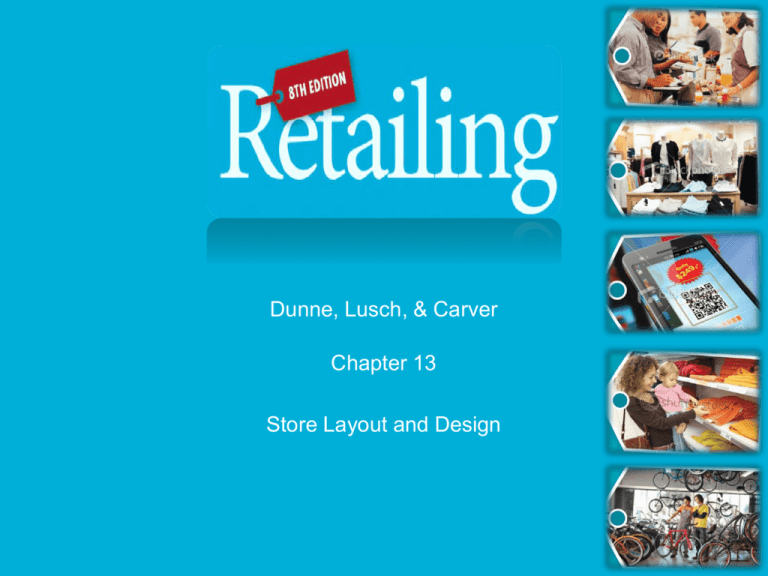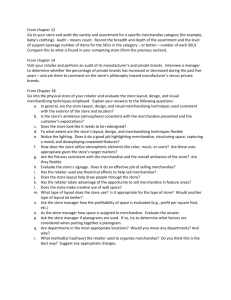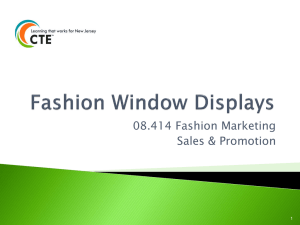Ch 13 - 8th Ed
advertisement

Dunne, Lusch, & Carver Chapter 13 Store Layout and Design Del Frisco’s - Dallas Del Frisco’s - Dallas Del Frisco’s - Denver Del Frisco’s - Denver Del Frisco’s - Houston Del Frisco’s - Houston Del Frisco’s - Houston Del Frisco’s – New York Del Frisco’s - New York Del Frisco’s – Philadelphia Del Frisco’s - Philadelphia Del Frisco’s - Philadelphia Del Frisco’s - Philadelphia Two Quick Videos on the Science of Layouts • Layout Video #1 • http://www.youtube.com/watch?v=g3IwOgA3Ng w&feature=related • Layout Video #2 • http://www.youtube.com/watch?v=RjgkQ6bq7aE &feature=related Why Focus on Store Layout Management? • Dallas Morning News Headline: “Shopper Found Dead in Local Store; Cause of Death – Boredom.” Stanley Marcus (Neiman Marcus) – ACRA 1993 Boredom & the Store Environment • Time Poverty • As consumers’ lives become increasingly time starved, customers are often entering retail stores with a negative feeling/emotion because they would rather be doing something else than shopping • Dissatisfaction with Shopping • Whether due to larger amounts of category management, cookie-cutter retailers, more time spent working, or changes in demographics… • So what? A “Clash for Cash” • Two Primary Objectives of the Store Environment 1. Store Image • How much do you spend to get customers into the store? • Affected by such things as: Location Promotional Activities Merchandise Cleanliness Employees Layout Lighting Service Offerings 2. Space Productivity • How much is necessary to keep customers inside the store for longer periods so that we can expose them to more products, thus increasing the probability that they purchase? Elements of the Store Environment Store Planning • “The better it is, the less you notice it as a customer” • Fundamentally concerned with the allocation of space and how it is used. • Floor Plan • A schematic that shows where merchandise and customer service departments are located, how customers circulate through the store, and how much space is dedicated to each department. Types of Space • Back room • Receiving areas for shipments & stockroom • Office & other functional areas • Break & training rooms, offices, and bathrooms • Aisles, service areas, and other non-selling space • Dressing rooms, service desks, etc. • Walls • Sales floor Space Allocation Planning • Requires the retailer to first analyze the profitability and productivity of various merchandise lines. • On average 20% of a retailer’s merchandise is either obsolete or unwanted by the retailer’s customer base. • Any productivity metric chosen must relate some performance variable (e.g., sales, GM, etc.) to the amount of space used in the store. Improving an Existing Store’s Space Productivity • Space Productivity Index • Compares the percentage of the store’s total GM for a category to the percentage of space allocated to that category (fig. 13.3) • Comparing Index Figures • 1.0 is ideal • If greater, • May want to increase allocation to make more money by having more product available • If less, • It’s underperforming, and may want to remove some space • Why only “maybe remove”? Space Allocations for a New Store • 2 Methods for Calculating Sales per Sq. Foot: • Traditional: • Total sales / total sq. ft. in the store • Bob Kahn’s approach: • Number of customers X the length of time in the store Warning Signs Indicating a Possible Space Problem Layout and Circulation Patterns: Free-Flow Layout Layout and Circulation Patterns: The Grid Layout Layout and Circulation Patterns: The Loop Layout Layout and Circulation Patterns: The Spine Layout Kohl’s “Modified” Loop Layout Layout and Circulation Patterns: The Spine Layout - Disney The Only Patented Layout – Clarence Sander’s Piggly Wiggly Planning Fixtures and Merchandise Presentation • Shrinkage Prevention • $40 billion lost annually by retailers from theft alone • Dramatically affected by one’s store layout and design • Key: Visibility of merchandise • Example: placement of offices & other security windows • Most theft occurs: • In changing rooms, blind spots, aisles crowded by “stack-outs”, or behind high displays • Traditionally, has led to display fixtures no higher than eye-level, but increased productivity of higher fixtures pushes some to overlook possibility for theft. Planning Fixtures and Merchandise Presentation • Increased emphasis on presentation as retailer seek to maximize sales out of existing square footage. • Two basic types of merchandise presentation: 1. On-shelf merchandising • The display of merchandise on counters, racks, shelves, and other fixtures throughout the store 2. Visual merchandising • • The artistic display of merchandise and theatrical props used as scene-setting decoration in the store. Typically not shoppable, but impacts affect and accessorization • Another example of how retailers can offer service without people – helps customers know what to buy Example of Visual Merchandising On-shelf Merchandising • “Shopping is a ‘contact’ sport” • Fixtures must not only present merchandise attractively, but also display in such a way that it’s easy to understand and is accessible. • It must also: 1. Be easy to maintain by the staff, as well as the customer 2. Eliminate any fear in the customer to actually touch because of fear of damaging the product or themselves Planning Fixtures and Merchandise Presentation • General Rule of Thumb: • “Match the fixture to the merchandise, not the merchandise to the fixture.” • Three categories of store fixtures: 1. Hardline fixtures • Examples: Gondola, tables, bins, flat-base deck 2. Softline fixtures • Bulk or capacity fixture • • Examples: Straight rack and Round rack (both sleeve-out) Feature fixture • Example: Four-way rack (face-out presentation) 3. Wall fixtures Four-Way Rack and Round Rack Merchandise Presentation and Likely Customer Affect & Price Image • Methods of merchandise presentation: 1. Shelving 2. Hanging 3. Pegging 4. Folding 5. Stacking 6. Dumping Merchandise Presentation and Likely Customer Angles or Sightlines Merchandise Presentation and Vertical Color Blocking Store Design • Overall goal is to create a desirable ambience • A function of at least four different factors: 1. Storefront design 2. Interior design 3. Lighting design 4. Sounds and smells Storefront Design • All successful retailers will have storefronts that are: 1. Noticeable 2. Memorable 3. Easily identifiable • Includes not only the store front décor, architecture, and building materials, but also window displays and any advertising • Poor performance here will dramatically lessen one’s overall traffic Storefront Design – Example: Victor Churchill Butcher Shop Storefront Design Interior Design • Focuses on two general elements: 1. Finishes applied to surfaces • • Flooring – Marble, wood, paint/stain, bare Wall coverings – color, sheen, texture, and fabrics/materials 2. Architectural shapes • • • • Archways Ceilings – vaulted versus fully-exposed Staircases Sunken floors Interior Design – Kubrick Bookshop (Beijing) Interior Design – Target Lighting Design • Lighting can greatly impact store sales; yet not always in a positive way. • Bright lighting • Pushes for customers to handle merchandise which may increase conversion • May suggest a discount-store image, particularly for fashion • Lighting to dissuade “undesirables” • Contemporary lighting design requires an in-depth knowledge of electrical engineering and the effect of light on color and texture. Lighting Design – Brother & Sister (Hong Kong) Sound & Smell Design • Total Sensory Marketing • Effective design appeals to four of the five human senses • Sight, Hearing, Smell, and Touch • The “Decompression Chamber” • While “sight” may the focal point, “smell” is believed to be most highly linked to memory and emotion. • Examples: Nike & old shoes; Disney & baked cookies • Sound can affect shopping speed Visual Communications • 5 General Areas of Visual Communication: 1. Name, Logo, and Retailer Identity 2. Institutional signage 3. Directional, Departmental, and/or Category signage 4. Point-of-Purchase (POP) signage 5. Lifestyle Graphics What You Should Have Learned… Chapter’s Learning Objectives 1. The elements of a store’s environment & its two primary objectives. 2. The steps involved in planning the store. 3. How various types of fixtures, merchandise presentation methods & techniques, and the psychology of merchandise presentation are used to increase the productivity of the sales floor. 4. Why store design is so important to a store’s success. 5. The role of visual communications in a retail store.




